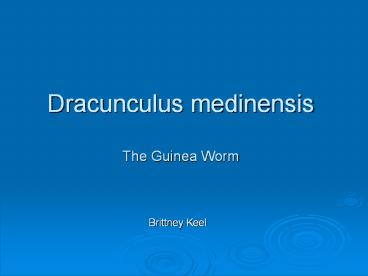Dracunculus medinensis The Guinea Worm - PowerPoint PPT Presentation
Title:
Dracunculus medinensis The Guinea Worm
Description:
The guinea worm, Dracunculus medinensis, has been known from very ancient times. ... http://www.astdhpphe.org/infect/guinea.html ... – PowerPoint PPT presentation
Number of Views:4414
Avg rating:3.0/5.0
Title: Dracunculus medinensis The Guinea Worm
1
Dracunculus medinensisThe Guinea Worm
- Brittney Keel
2
Review
- Scientific name - Dracunculus medinensis
- Common name - Guinea worm, medina worm, serpent
worm - One of the largest nematodes, males are
approximately 40 mm long and females are 80 cm
long - It is transmitted from the intermediate host the
Copepod to the definitive host the Human.
3
Historical Accounts
- The guinea worm, Dracunculus medinensis, has been
known from very ancient times. - Egyptian mythology pertaining to the Serpent of
Isis has been postulated as relating to
dracunculiasis. The "plague of the fiery
serpents" which decimated the Hebrews during the
Exodus from Egypt, as described in the Book of
Numbers. - Early Greek and Roman physicians associated the
disease with certain watering holes and wells.
Arab and Persian writers of the Middle Ages
described the disease and a Persian doctor of the
10th century identified a worm as its cause. - This nematode was known as a parasite of humans
about 1530 B.C. Some investigators suggest that
the Guinea worm is the "fiery serpent" referred
to in the Bible. The symbol of a Physician is the
"Caduceus". This is the staff of Hermes and
contains coiled serpents on a staff. The serpents
are believed to represent the Guinea worm.
4
Discovery
- The Ebers papyrus, dating from 1550 B.C.,
described the disease and its primitive
treatment, still used in most endemic areas
today. A calcified guinea worm was discovered in
the abdominal cavity of an adolescent Egyptian
mummy. - Scientists studied Dracunculiasis, but did not
discover the full life cycle. - D. medinensis complete life cycle was discovered
by Alekei Pavlovitch Fedchenko in 1870. - Indian bacteriologist, Dyneshvar Atmaran Turkhud,
solidified Fedchenkos knowledge in 1913
Persian physicians removing the Dracunculus
medinensis parasite from the leg of a patient
5
Cultural Practices
- People in endemic areas such as Africa, Sudan,
and India contribute to the transmission of the
disease by placing there infected limb/limbs in
water to relieve the pain that the worm causes,
and then drinking the contaminated water.
6
Distribution Prevalence
- The Guinea worm is found mostly in Africa, but is
also found in India, Pakistan, Saudi Arabia, and
Yemen. - Infects approximately 10 million people per
year. The majority of human infections occur in
parts of West Africa, East Africa, and India.
7
Prevention Treatment
- To stop the infection of the Guinea worm you must
keep Guinea worm larvae out of the drinking
water. Use only water that has been filtered or
obtained from a safe source. - Water can be boiled, filtered through tightly
woven nylon cloth, or treated with a
larvae-killing chemical. People with an open
Guinea worm wound should not enter ponds or wells
used for drinking water. - There is no cure. The only treatment is to remove
the worm over many weeks by winding it around a
small stick and pulling it out a tiny bit at a
time. Sometimes the worm can be pulled out
completely within a few days, but the process
usually takes weeks or months. - No medication is available to end or prevent
infection. However, the worm can be surgically
removed before the wound begins to swell.
Antihistamines and antibiotics can reduce
swelling and ease removal of the worm.
8
References
- http//www.stanford.edu/class/humbio103/ParaSites2
006/Dracunculiasis/history.html - http//www.who.int/en/
- http//www.astdhpphe.org/infect/guinea.html
- http//ucdnema.ucdavis.edu/imagemap/nemmap/Ent156h
tml/nemas/dracunculusmedinensis


























![Basic Concepts in Public Health and Tropical Medicine [Infectious Diseases and Public Health 101] (mainly in relationship to parasitic diseases) PowerPoint PPT Presentation](https://s3.amazonaws.com/images.powershow.com/3881380.th0.jpg?_=201301071211)
![Basic Concepts in Public Health and Tropical Medicine [Public Health & Infectious Diseases 101] (mainly in relationship to parasitic diseases) PowerPoint PPT Presentation](https://s3.amazonaws.com/images.powershow.com/4061901.th0.jpg?_=201307160511)



